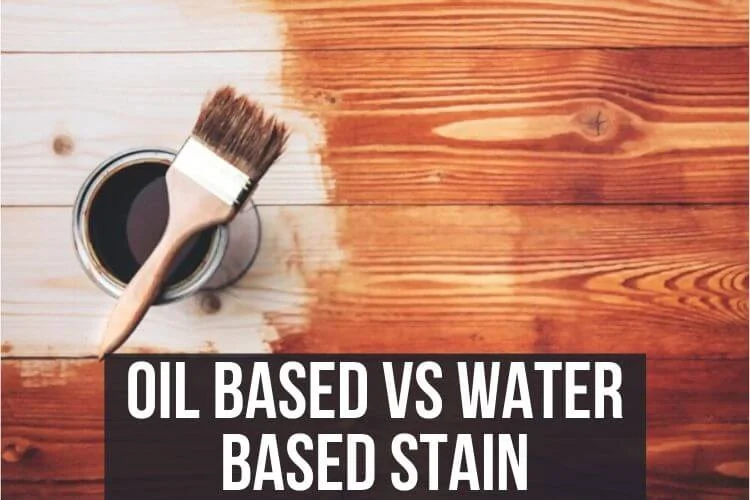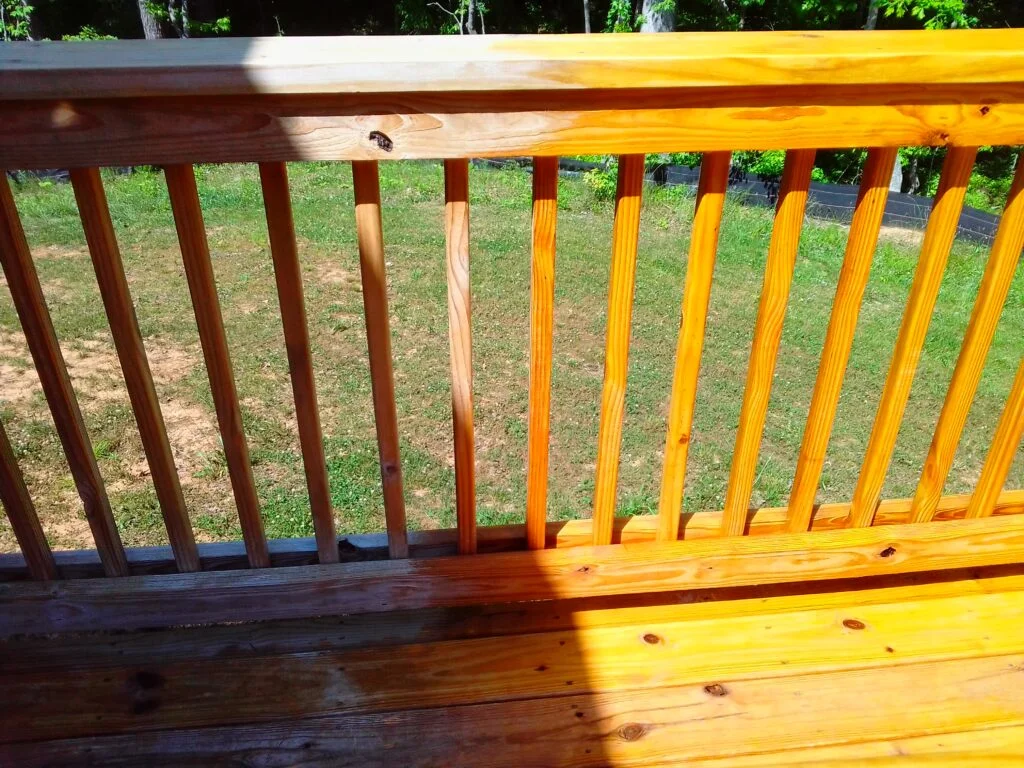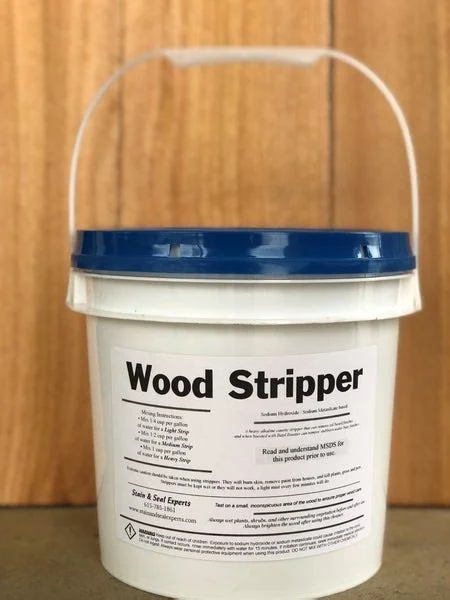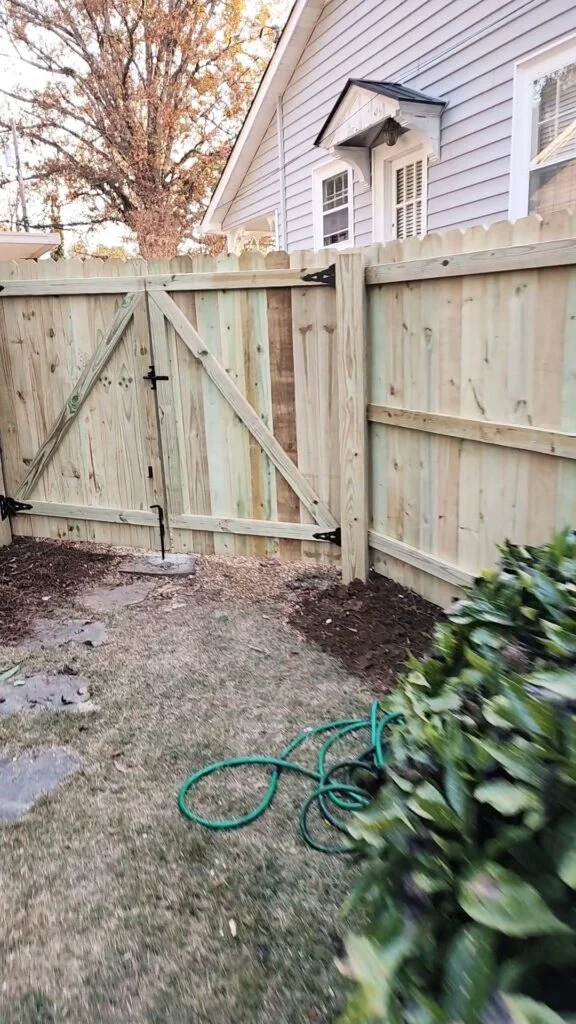Answers to common staining questions

If you're planning to stain your deck or Fence, you may be wondering whether to choose a water or oil-based stain. While both options have their pros and cons, here are a few factors to consider when making your decision:
Dry time: One of the main differences between water and oil-based stains is the dry time. Water-based stains typically dry much faster than oil-based stains, making them a good choice for homeowners who want to complete the staining process quickly. Oil-based stains, on the other hand, may take several hours or even days to fully dry, depending on the humidity and temperature.
VOCs: Volatile Organic Compounds (VOCs) are chemicals that are released into the air as the stain dries. Oil-based stains typically have higher levels of VOCs than water-based stains, which can be harmful to the environment and to your health. If you are concerned about the impact on the environment or your own health, a water-based stain may be the better choice.
Durability: When it comes to durability, oil-based stains tend to be more long-lasting than water-based stains. They penetrate deeper into the wood, providing better protection against the elements and wear and tear. Water-based stains, on the other hand, may not provide as much protection and may need to be reapplied more frequently.
Appearance: The final appearance of the stain can also be a factor in your decision. Water-based stains tend to have a more natural, matte finish, while oil-based stains may have a more glossy finish. Some people prefer the look of one over the other, so it's a matter of personal preference.
Ultimately, the choice between a water or oil-based stain will depend on your priorities and needs. Both options have their advantages and disadvantages, so be sure to consider the factors above and consult with a professional if you have any doubts.
If you're planning to stain your deck or Fence, you may be wondering whether to choose a water or oil-based stain. While both options have their pros and cons, here are a few factors to consider when making your decision:
Dry time: One of the main differences between water and oil-based stains is the dry time. Water-based stains typically dry much faster than oil-based stains, making them a good choice for homeowners who want to complete the staining process quickly. Oil-based stains, on the other hand, may take several hours or even days to fully dry, depending on the humidity and temperature.
VOCs: Volatile Organic Compounds (VOCs) are chemicals that are released into the air as the stain dries. Oil-based stains typically have higher levels of VOCs than water-based stains, which can be harmful to the environment and to your health. If you are concerned about the impact on the environment or your own health, a water-based stain may be the better choice.
Durability: When it comes to durability, oil-based stains tend to be more long-lasting than water-based stains. They penetrate deeper into the wood, providing better protection against the elements and wear and tear. Water-based stains, on the other hand, may not provide as much protection and may need to be reapplied more frequently.
Appearance: The final appearance of the stain can also be a factor in your decision. Water-based stains tend to have a more natural, matte finish, while oil-based stains may have a more glossy finish. Some people prefer the look of one over the other, so it's a matter of personal preference.
Ultimately, the choice between a water or oil-based stain will depend on your priorities and needs. Both options have their advantages and disadvantages, so be sure to consider the factors above and consult with a professional if you have any doubts.

Why Use a Deck Brightener
If you're considering using a deck brightener on your wood deck or have never heard of it before, you may be wondering what benefits it provides. Here are a few reasons why using a deck brightener can be beneficial:
Revives faded wood: Over time, wood decks can become faded and discolored due to exposure to the sun and the elements. A deck brightener can help to revive the natural color of the wood, giving it a refreshed and rejuvenated look.
Enhances wood grain: Deck brighteners contain mild acids that help to gently remove dirt, grime, and other contaminants from the surface of the wood. This can help to enhance the wood grain and bring out the natural beauty of the wood.
Prepares wood for staining: If you're planning to stain your deck, using a deck brightener can help to prepare the wood for the stain by removing any contaminants that could interfere with the adhesion of the stain. This can help to ensure that the stain goes on evenly and provides the best possible coverage.
Easy to use: Deck brighteners are easy to use and can typically be applied with a garden sprayer or a roller. Simply mix the brightener with water according to the manufacturer's instructions and apply it to the surface of the wood. After allowing it to sit for the recommended amount of time, simply rinse it off with a garden hose.
Using a deck brightener can be a simple and effective way to enhance the appearance and extend the life of your wood deck. If you're considering using a deck brightener, be sure to follow the manufacturer's instructions and take proper safety precautions.
If you're considering using a deck brightener on your wood deck or have never heard of it before, you may be wondering what benefits it provides. Here are a few reasons why using a deck brightener can be beneficial:
Revives faded wood: Over time, wood decks can become faded and discolored due to exposure to the sun and the elements. A deck brightener can help to revive the natural color of the wood, giving it a refreshed and rejuvenated look.
Enhances wood grain: Deck brighteners contain mild acids that help to gently remove dirt, grime, and other contaminants from the surface of the wood. This can help to enhance the wood grain and bring out the natural beauty of the wood.
Prepares wood for staining: If you're planning to stain your deck, using a deck brightener can help to prepare the wood for the stain by removing any contaminants that could interfere with the adhesion of the stain. This can help to ensure that the stain goes on evenly and provides the best possible coverage.
Easy to use: Deck brighteners are easy to use and can typically be applied with a garden sprayer or a roller. Simply mix the brightener with water according to the manufacturer's instructions and apply it to the surface of the wood. After allowing it to sit for the recommended amount of time, simply rinse it off with a garden hose.
Using a deck brightener can be a simple and effective way to enhance the appearance and extend the life of your wood deck. If you're considering using a deck brightener, be sure to follow the manufacturer's instructions and take proper safety precautions.

Types of Wood Cleaning Solutions
There is no one solution or chemical that is right for every job. Knowledge of wood species, sealers and chemical reactions are all factors in determining the best course of action for wood restoration. For wood restoration its best to go with the rule of conservation which means using the mildest treatment that gives acceptable results.
1) Sodium Per-carbonate – Advantages to sodium per-carbonate wood cleaners include; ease of use, emulsifies dirt, safe for vegetation, wood color retention and does not cause respiratory distress. The emulsification of dirt allows for easier low pressure cleaning. Disadvantages to sodium per-carbonate is a slightly higher cost of materials and requires a longer dwell time to effectively kill mold. In some extreme cases it may not be able to eradicate mold completely. Sodium per-carbonate by itself is an Alkaline(basic) with a pH around 10.5. To neutralize we also apply oxalic acid based brighteners and rinse.
2) Sodium Hydroxide – This chemical is primarily used to emulsify previous coatings of stain, dead wood and dirt. When you purchase a pre-formulated stripping solution, surfactants, buffers and other misc. chemicals are added to work in synergy with NaOH. Sodium Hydroxide is extremely caustic and will irritate eyes, skin and respiratory system. Follow the manufacturers guidelines for personal protective equipment (PPE). Pure Sodium Hydroxide(basic) ranges between 12 and 14 on the pH scale. To neutralize we apply citric/oxalic acid and rinse.
3) Sodium Metasilicate – Sodium metasilicate is a cleaning agent that can be used on its own as a cleaner for wood and metal and as an ingredient for other products like soaps and detergents. Chemically speaking, sodium metasilicate is known as an alkali salt, which gives it great stain lifting properties and the ability to kill off mold, moss, and other organic growths on your wood. Sodium metasilicate, if mixed with a high enough concentration, could also be used to strip wooden decks to prepare them for their new coat of paint, varnish, or sealer.

When it comes to fencing options for your backyard, it can be overwhelming to decide on the best type for your needs and budget. Here are a few factors to consider when choosing the right fence for your backyard:
Purpose of the fence: The first step in selecting the right fence is to determine its primary purpose. Do you want a fence to provide privacy, create a boundary, or simply enhance the look of your backyard? Different types of fences are better suited for different purposes, so it's important to think about your needs before making a decision.
Material: The material of the fence is another important consideration. Wood, vinyl, and aluminum are all popular options, each with their own unique benefits. Wood is a classic choice that can be stained or painted to match your home's exterior. Vinyl is a low-maintenance option that resists rot and fading, but is more expensive upfront. Aluminum is a durable, rust-resistant choice, but may not provide as much privacy as other materials.
Budget: Your budget is another important factor to consider when choosing a fence. While wood and vinyl tend to be more expensive upfront, they may require less maintenance over time. Aluminum is generally a more affordable option, but may not be as durable as other materials.
Maintenance: Consider the amount of maintenance you are willing to commit to in order to keep your fence looking its best. Wood fences require regular staining or painting to protect them from the elements, while vinyl and aluminum require minimal maintenance.
Local regulations: Be sure to check with your local municipality to see if there are any building codes or regulations that you need to follow when installing a fence. Some neighborhoods may have restrictions on the height or type of fence that is allowed.
By considering these factors, you can determine the best type of fence for your backyard. Don't be afraid to consult with a professional fence installation company for additional guidance and recommendations.
When it comes to fencing options for your backyard, it can be overwhelming to decide on the best type for your needs and budget. Here are a few factors to consider when choosing the right fence for your backyard:
Purpose of the fence: The first step in selecting the right fence is to determine its primary purpose. Do you want a fence to provide privacy, create a boundary, or simply enhance the look of your backyard? Different types of fences are better suited for different purposes, so it's important to think about your needs before making a decision.
Material: The material of the fence is another important consideration. Wood, vinyl, and aluminum are all popular options, each with their own unique benefits. Wood is a classic choice that can be stained or painted to match your home's exterior. Vinyl is a low-maintenance option that resists rot and fading, but is more expensive upfront. Aluminum is a durable, rust-resistant choice, but may not provide as much privacy as other materials.
Budget: Your budget is another important factor to consider when choosing a fence. While wood and vinyl tend to be more expensive upfront, they may require less maintenance over time. Aluminum is generally a more affordable option, but may not be as durable as other materials.
Maintenance: Consider the amount of maintenance you are willing to commit to in order to keep your fence looking its best. Wood fences require regular staining or painting to protect them from the elements, while vinyl and aluminum require minimal maintenance.
Local regulations: Be sure to check with your local municipality to see if there are any building codes or regulations that you need to follow when installing a fence. Some neighborhoods may have restrictions on the height or type of fence that is allowed.
By considering these factors, you can determine the best type of fence for your backyard. Don't be afraid to consult with a professional fence installation company for additional guidance and recommendations.
